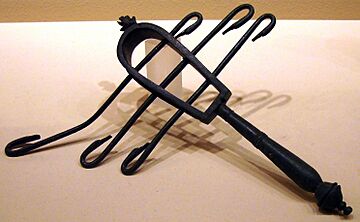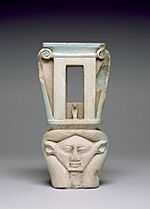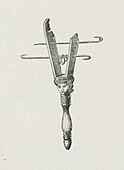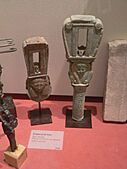Sistrum facts for kids
A sistrum (plural: sistra) is a musical instrument from the percussion family, similar to a rattle. It was very popular in ancient Egypt. The name sistrum comes from a Greek word that means "that which is being shaken."
A sistrum has a handle and a U-shaped metal frame, usually made of brass or bronze. Metal bars with small metal rings are fitted across the frame. When someone shakes the sistrum, the rings slide and hit each other, making a sound that can be a soft jingle or a loud clang.
In the ancient Egyptian language, its name was sekhem or sesheshet. The name sesheshet was meant to sound like the rattling noise the instrument made. The sistrum was a very important instrument in religious ceremonies for the ancient Egyptians.
There were two main types. The sekhem was a simpler, hoop-shaped sistrum. The sesheshet was shaped like a small shrine, called a naos. Today, the word sistrum is also used for similar rattle instruments from West Africa.
Contents
The Sistrum in Ancient Egypt
In ancient Egypt, the sistrum was a sacred instrument used in religious ceremonies and dances. It was especially important in the worship of the goddess Hathor. Hathor was often shown with the features of a cow, and the U-shape of the sistrum was thought to look like her face and horns.
The sound of the sistrum was believed to please the gods and goddesses. People thought its rattling sound had special powers. They shook it to try to prevent the flooding of the Nile River from being too destructive and to scare away Set, the god of chaos.
Usually, only women, especially priestesses, played the sistrum in rituals. However, during special festivals, the king might play it as an offering to Hathor.
Other goddesses were also connected with the sistrum.
- Isis, the goddess of motherhood, was often shown holding a sistrum in one hand and a pail of water in the other to represent the Nile's flood.
- Bast, the cat goddess of dance and joy, was also frequently shown holding a sistrum.
Even today, sistra are used in the religious services of the Alexandrian Rite and Ethiopic Rite churches. The instrument is often seen in Egyptian art and mentioned in Egyptian stories.
The Sistrum in Ancient Crete
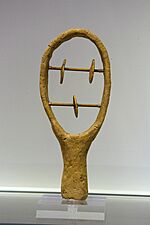
The sistrum wasn't just used in Egypt. The ancient Minoans, who lived on the island of Crete, also had this instrument. Archaeologists have found several sistra made of clay in Crete. Some of these can be seen in the Archaeological Museum of Agios Nikolaos.
Scientists are not completely sure if these clay sistra were real instruments or just models used as symbols. However, when they made a copy of a clay sistrum, they found it made a good rattling sound. This suggests the Minoans probably used them in their ceremonies, much like the Egyptians. The Minoans may have used them in rituals for music, dancing, and celebrations.
The Sistrum in Later Times
In Churches and Modern Groups
The sistrum, called a senasel in Ethiopia, is still a liturgical instrument (used in worship) in the Ethiopian Orthodox Church. It is played during dances performed by the debtera (church singers) on important religious holidays. The sistrum is also sometimes used today in modern spiritual groups that are inspired by ancient traditions.
In Classical Music
The sistrum has also appeared in Western orchestral music. The French composer Hector Berlioz included it in his opera Les Troyens. Today, an orchestra will usually use a tambourine instead, as it makes a similar sound.
The exciting, rhythmic sound of a sistrum or a tambourine is often linked with celebrations and happy events. It can be a sacred rattle in an ancient Egyptian temple or the jangling of a tambourine at a modern concert.
Modern Sistra in West Africa
In West Africa and Gabon, there are modern instruments that are also called sistra. One common type is the calabash sistrum or disc rattle. It is often made from a V-shaped tree branch with dried, hollowed-out gourds (calabash discs) attached to it. When shaken, these discs rattle against each other.
Gallery
-
Nefertari, wife of Ramesses II, holding a sekhem-type sistrum
-
A collection of sistra at the Louvre museum in Paris
-
A sistrum from around 380–250 BCE, now in the Walters Art Museum
-
A Roman coin from the time of Emperor Hadrian, showing a seated woman with a sistrum
See also
- Kagura suzu (Shinto)


